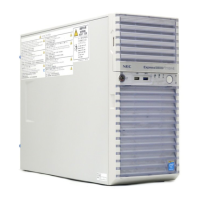2. Setting up
Express5800/R320e-E4, R320e-M4 Installation Guide (Linux)
25
Chapter 1 Installing Operating System
*5 The following table shows the recommended swap partition size in accordance with the memory space
mounted in this machine.
Mounted memory space swap partition size
8 GB or less Mounted memory space
More than 8 GB and 64 GB or
less
Half of the mounted memory
space
More than 64 GB Depends on the workload.
Note If the mounted memory space is larger, swap is hardly used in some cases. Determine
the size according to the purpose of using the system and the workload during the
operation.
The free command enables you to check the swap use status during the operation. If
the usage rate of swap is higher, expand the swap area and add the memory.
*6 The partitions can be created freely in this free space. For the procedure for adding the partitions, see
the following sections.
- Chapter 1 (3.3 Adding Partitions) in this manual
- Chapter 1 (3.4 Expanding the swap Area) in this manual
Important
For the partitions created by all the built-in hard disks, the software RAID1
consisting of the CPU/IO module 0 and CPU/IO module 1 with the same slot
numbers must be configured. Only RAID1 is supported for the built-in hard disk
including the system partition. RAID1 or RAID1+0 is supported for the built-in
hard disk excluding the system partition. For the built-in hard disk excluding the
system partition, see Chapter 2 (1. Hard Disk Drive Duplexing) in the
maintenance manual.
The built-in hard disk including the system partition does not support the use of LVM.
Configure RAID1 or RAID1+0 before using the built-in hard disk excluding the system
partition. Please note that the configuration to create RAID furthermore on the LVM
logical volume is not supported. LVM provides the advanced storage function and the
procedure for management or recovery in case of a failure is complex. It is
recommended to use LVC only if it is required.
Tips The number of the partition created during the installation is automatically allocated by
the Red Hat installation program. Therefore, the numbers may not be allocated in the
same order as creation of the partition.
Use the parted command or df command to display the partition information or free
space of the hard disk drive.

